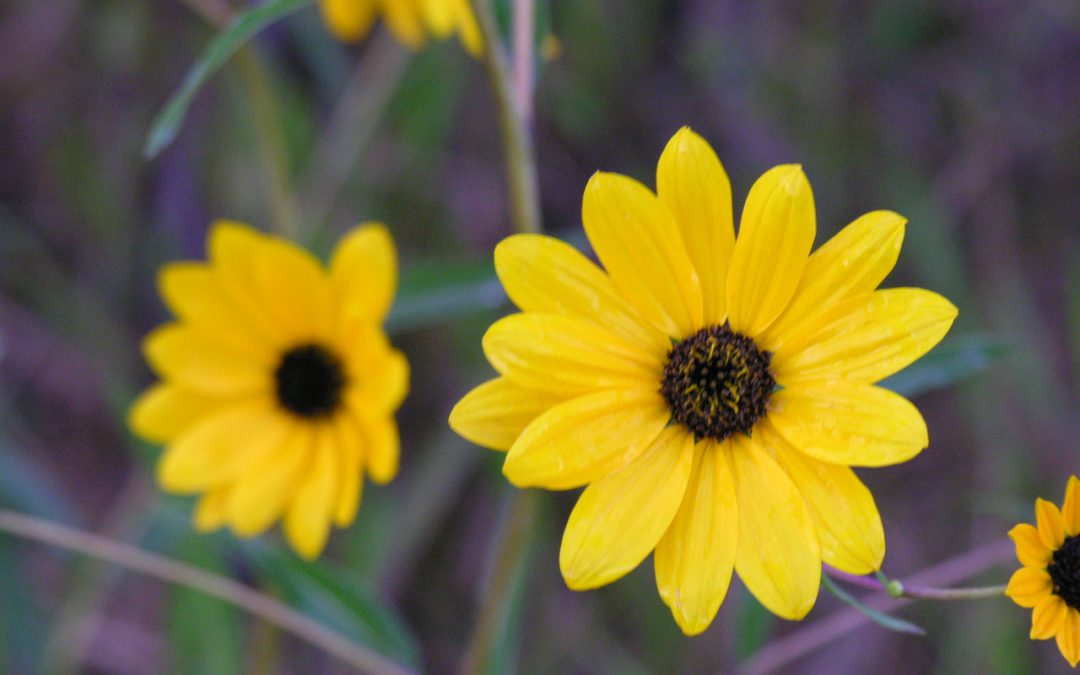
by Taylor Vandiver | Apr 14, 2015
Rain gardens are an easy way to return water to our aquifer, reduce erosion, and help prevent stormwater runoff.
Running down the driveway or patio, rainwater can pick up lawn chemicals and pesticides. A rain garden is basically a low section of the landscape planted with native plants that like to get their “feet” wet. The garden collects rainwater, giving it a chance to “strain” out impurities before draining into the aquifer.

Swamp sunflower. Photo courtesy UF/IFAS.
They work best when they’re placed at the bottom of downspouts or naturally low spots in the landscape, usually where water tends to puddle. They’re especially useful for collecting runoff from paved surfaces. Rain gardens can be any size or shape and can attract thirsty wildlife.
When selecting plants, you’ll need to consider how much sun your site gets and how much space is available. Make sure you select plants that are not just water-tolerant, but also drought-tolerant for the times between rains.
Rain gardens rely on plants that will survive dry spells but then soak up excess stormwater during Florida’s rainy months, preventing the water from running across your landscape.
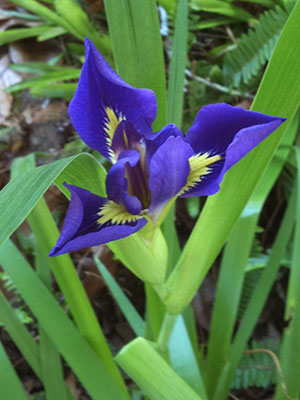
Blue flag iris. Photo courtesy UF/IFAS.
Include different types of plants in your rain garden to create a complete and cohesive look that will provide year-round interest. The following is a short list of flowers, shrubs, and grasses that would perform well in a rain garden.
Flowers:
- Blue flag iris
- Goldenrod
- Swamp sunflower
- Spider lily
- Milkweed
Grasses:
- Florida gamma grass
- Muhly grass
- Wiregrass
Shrubs:
- Virginia willow
- Buttonbush
- Wax myrtle
Here is a list of native plants that will do well in your North Florida rain garden. As always consult your local Extension Office for more information. All of the information in this article was provided by UF/IFAS Extension.
by Julie McConnell | Apr 13, 2015

New foliage of Japanese Plum Yew Photo credit: Julie McConnell, UF/IFAS
Trying to grow turfgrass in shaded areas is a losing battle but that doesn’t mean you have to settle for mulch in those dark areas of the landscape. There are many plants that will tolerate shady conditions found under the canopy of large trees, and some offer year round interest!
One of the most important aspects of site assessment is sun exposure. Plants need light, but do not all need the same amount or intensity.
If plants requiring full sun are planted in the shade, they tend to get leggy and do not flower well. Although they may live, they will not perform at their peak.
Shade loving plants grown in the sun may be stunted, show leaf scorch, and will struggle. Most shade plants can tolerate some filtered light or morning sun, but need to be protected from direct mid-day to afternoon sun.
So, what evergreen plants can add some color and texture to your shaded spots?
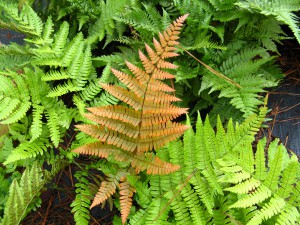
Golden tones of new foliage is what gives Autumn Fern its common name. Photo credit: Julie McConnell, UF/IFAS
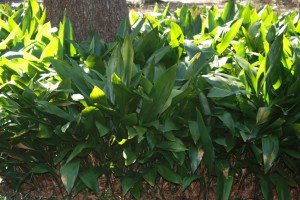
Cast Iron Plants under a live oak tree. Photo credit: Julie McConnell, UF/IFAS
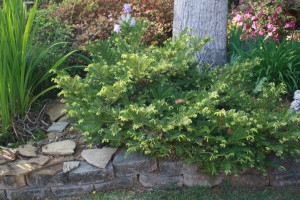
Japanese Plum Yew. Photo credit: Julie McConnell, UF/IFAS
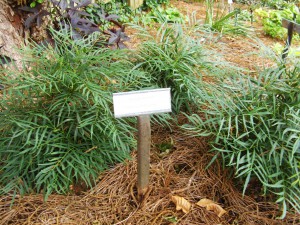
Soft Caress Mahonia. Photo Credit: Julie McConnell, UF/IFAS
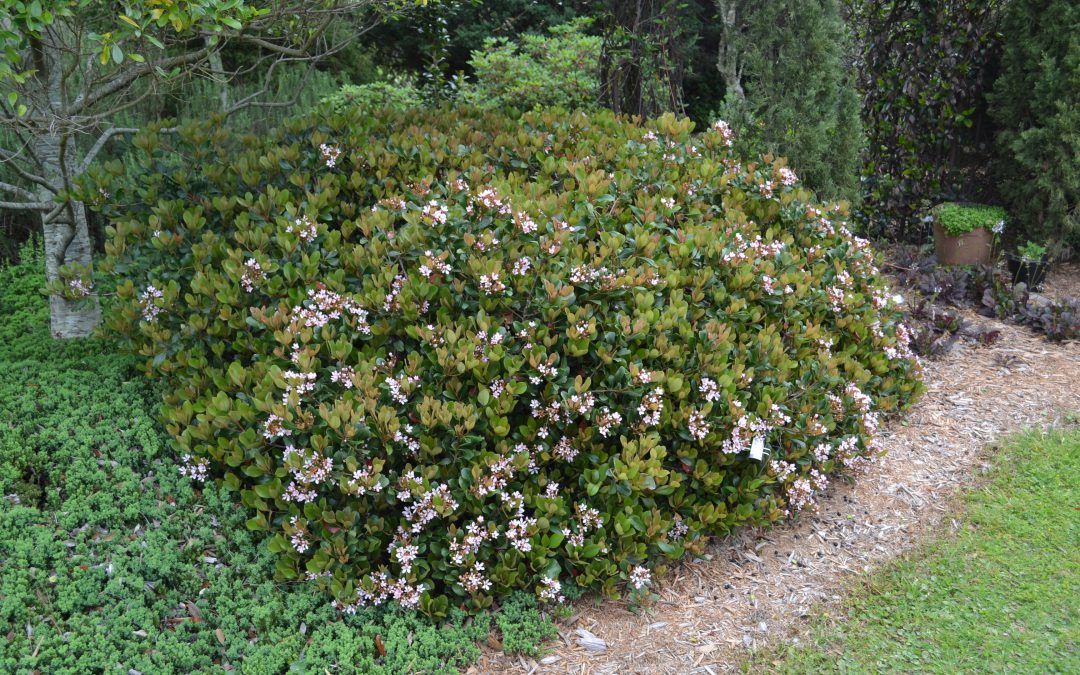
by Beth Bolles | Apr 7, 2015
One of the most commonly used shrubs in landscapes is the Indian hawthorn, Rhapheolepsis indica. Although not native to Florida, it can be a very attractive shrub when used properly in landscapes. Plants offer spring flowers in pinks and whites followed by berries that are a food source for birds.
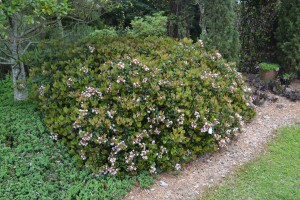
Indian hawthorn as a single planting can be attractive.
Indian hawthorn plants in landscapes are susceptible to a couple of pests that create unattractive and unhealthy plants. A leaf spot fungus called Entomosporium leaf spot easily spreads from infected plants through irrigation and rainfall leading to leaf discoloration, leaf drop, and dieback of limbs. Scale insects can also be common on leaves causing yellowing and dieback. The fungal problem is difficult to manage on heavily infected plants but the scale can be managed with a low toxicity pesticide choice such as a horticulture oil.
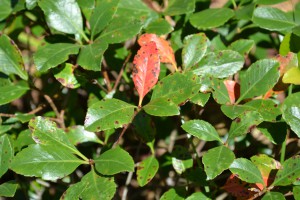
A heavy infection of leaf spot fungi is often too difficult to manage when plants are routinely irrigated.
Most often the problems on Indian hawthorn, especially fungal, are the result of poor management. This shrub likes sun, well-drained soil, and no overhead irrigation. Once established, plants should need little supplemental irrigation and water should only be applied to the base of plants. Since plants normally form a rounded mound, there is also little need for pruning if planted in a correct spot and spaced appropriately when planting. Most landscape installations of Indian hawthorn space plants based on the gallon pot size and not the mature size of the plant which is about 3-5 feet in height and spread.
Indian hawthorn can still be a good selection for homeowners. Buy healthy plants without any signs of spots on leaves and don’t plant a monoculture of these plants in the landscape. If one plant does have serious pest issue it is easier to either treat or remove one plant versus a mass planting.
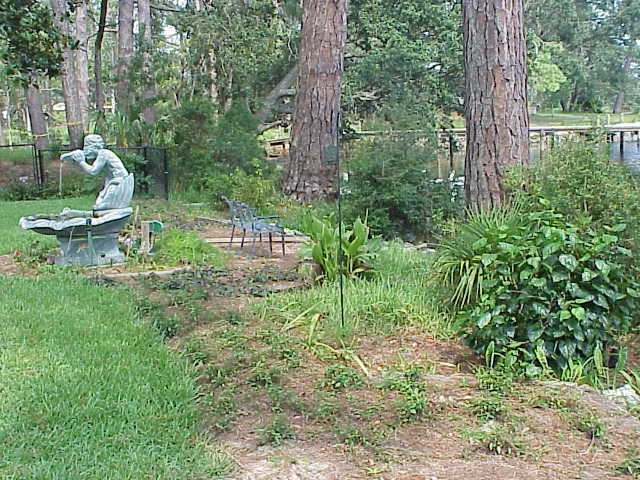
by Carrie Stevenson | Mar 17, 2015
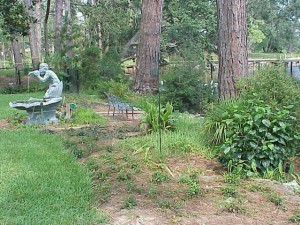
A waterfront buffer zone may include a raised berm with native vegetation to slow runoff from a yard before entering the water. Photo credit: Carrie Stevenson
A taste of spring weather has arrived, and people will soon be filling the home improvement stores and getting ready for outdoor projects. If you live on the water or near a storm drain, it’s worth considering buffer zones and best management practices for fertilizing and lawn maintenance.
A waterfront buffer zone is an area the length of one’s property line, typically running about 10 feet (although it can be wider) from the edge of a shoreline (or even a storm drain) into the yard. In this area, the homeowner allows native vegetation to grow along the water and uses low-maintenance plants within the buffer. In this zone, no fertilizers or pesticides are used. Some homeowners will build a small berm to divide the area of maintained lawn (uphill) from the downhill waterfront side. This berm may be composed of a mulched area with shrubbery to catch and filter runoff from the more highly maintained lawn. This combination of actions helps treat potentially polluted stormwater runoff before it reaches the water, and keeps homeowners from using chemicals close to the water. It is often quite difficult to grow turf next to the water, anyway, and this takes the pressure off of someone trying to grow the perfect lawn down to the water’s edge. The buffer zones are often quite attractive and can be an excellent transition between managed turf and the waterfront.
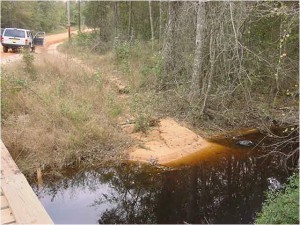
Unmaintained dirt roads along creeks are significant sources of sediment, which can harm the bottom-dwelling insects that form the base of the food web. Photo credit: Carrie Stevenson
Erosion prevention is crucial along waterways, as well. An open, non-vegetated lot can contribute a significant amount of sediment to a storm drain, stormwater pond, or natural body of water. Whether grass, trees, or bushes, any kind of vegetation is preferable to soil washing out of a yard and into the water. Sediment is a problem because it causes water clarity to drop, which can prevent seagrasses from getting the sunlight they need. Once settled, underwater sediment can form a stifling layer that chokes out small insects and invertebrates, which live in the soil and form the basis of the aquatic food chain. With no fish food available, fish may die or move out of an area. The most dramatic examples of this can often be found at dirt roads that cross over creeks. If not managed properly, the clay on these roads can nearly bury a small stream.
Other lawn care techniques for protecting the waterfront and preventing stormwater pollution include not mowing along the water, using a deflector shield and staying 3’-10’ away from the water’s edge when fertilizing, and not allowing grass clippings to blow into storm drains. Large amounts of decaying grass in a waterway can use up available oxygen, endangering aquatic organisms. When applying granular fertilizer, be sure to sweep up any spills on concrete so it doesn’t run into a storm drain. When cutting grass, mow at the highest height recommended for your turf to encourage deep rooting and stress tolerance. Healthy turf is better able to withstand drought, pests, and choke out weeds, reducing the frequency of pesticide and water application.
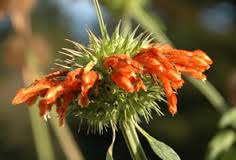
by Sheila Dunning | Mar 2, 2015
“If March comes in like a lion, it will go out like a lamb?”
Weather sayings can be quite colorful. Some of them may be connected to scientific observations, while others are more superstitious in nature. What the weather will do this month can change on a moment’s notice. March is definitely one of the more unpredictable months. One week the temperatures are warm and spring-like. A few days later the weather turns stormy and cold. Depending on the groundhog you follow, spring will be here, or not, in the next few weeks.
But, any long time Northwest Florida residents knows, summer will be here eventually and it is going to get hot and dry. So, while trying to figure out whether to wear your T-shirt or arctic parka today, take a moment to locate “that patch” of the landscape and consider adding a “lion” or “lamb.”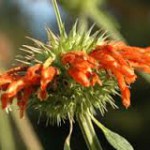
Lion’s ear and Lamb’s ear are two plants that survive under hot, dry conditions. Lion’s ear, Leonotis nepetifolia, is a tall-growing (8 feet) annual with orange tubular flowers that peek out of the spiny bloom head, giving the appearance of a lion’s ear. Hummingbirds reportedly hover next to a flower or even perch on a cluster, drinking for 10 seconds or longer. That’s an eternity in hummer world and about as long as any lion would tolerate someone messing with his ears.
nepetifolia, is a tall-growing (8 feet) annual with orange tubular flowers that peek out of the spiny bloom head, giving the appearance of a lion’s ear. Hummingbirds reportedly hover next to a flower or even perch on a cluster, drinking for 10 seconds or longer. That’s an eternity in hummer world and about as long as any lion would tolerate someone messing with his ears.
 Lamb’s ear, Stachys byzantina, is an easy care perennial with wooly gray-green leaves and lavender colored flower spikes. It makes an attractive accent in a container or excellent groundcover that invites you to experience its soft “wool”, like those cute little ears of a baby sheep.
Lamb’s ear, Stachys byzantina, is an easy care perennial with wooly gray-green leaves and lavender colored flower spikes. It makes an attractive accent in a container or excellent groundcover that invites you to experience its soft “wool”, like those cute little ears of a baby sheep.
Both of these plants are self-sustaining species that establish well in open dry areas. The lion’s ear must self sow seed to return each year. Whereas, the lamb’s ear will return from the roots and can be divided if relocation is desired.
Lion or lamb, March is a good time to plan for easy care, summer, blooming flowers. While it may be “freezing” now, you know once it gets hot, the last place you will want to be is outside in the blazing sun. Maybe the thoughts will warm you.
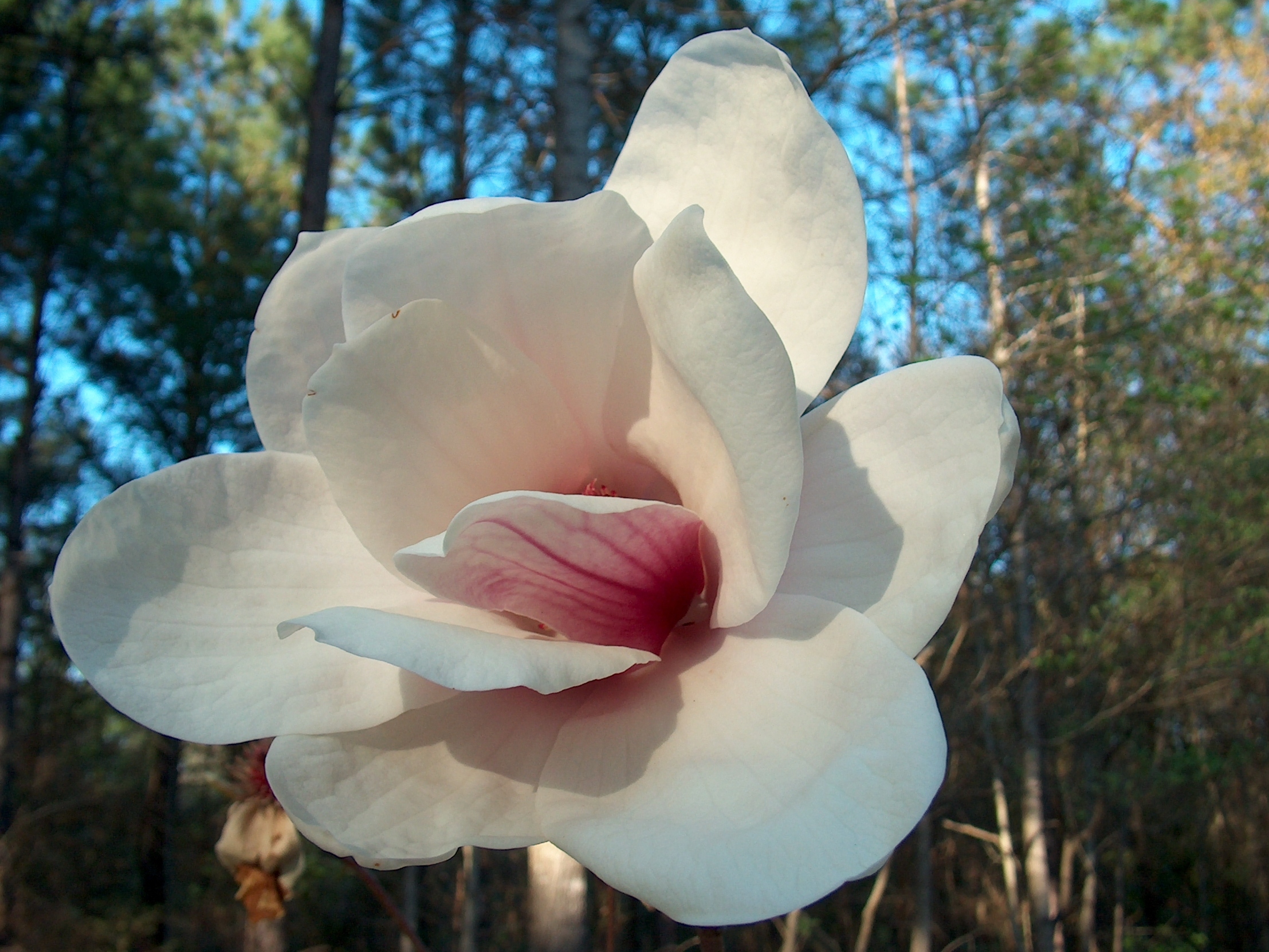
by Gary Knox | Feb 24, 2015
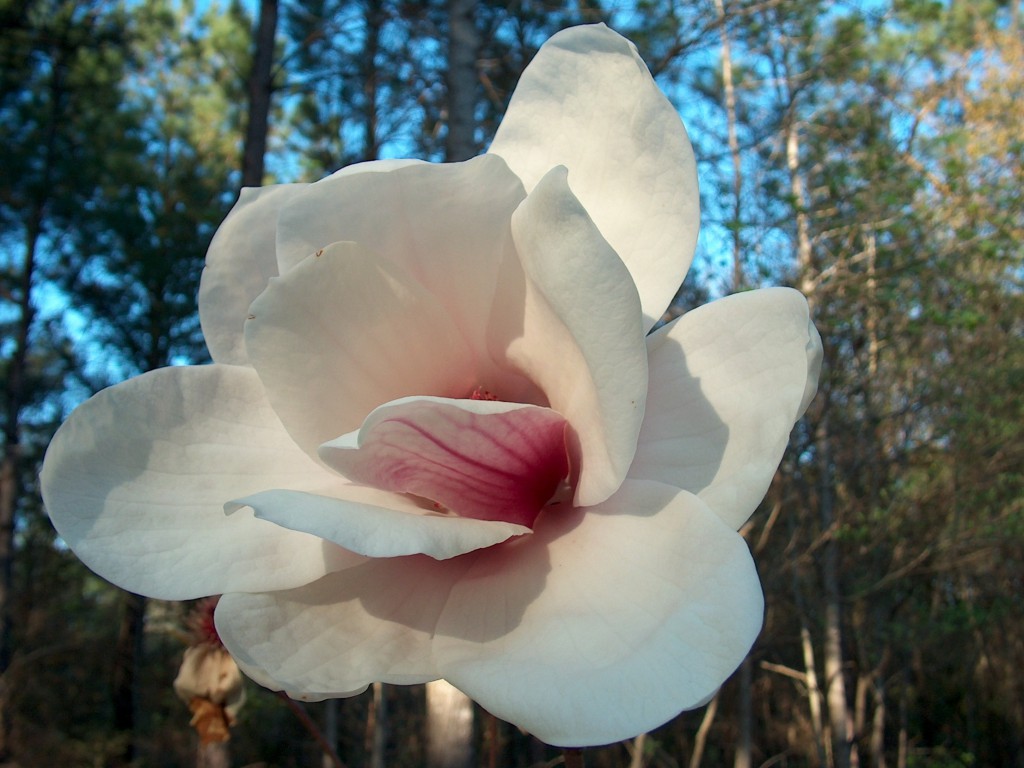
‘Jon Jon’ magnolia
This winter’s recurring freezes and frosts have played havoc with early flowering plants like magnolia. While buds are freeze-resistant, open magnolia flowers can quickly turn brown after exposure to temperatures about 30°F or lower. One way to avoid freeze-damaged flowers is to choose later blooming cultivars. These selections have flowers that open in north Florida during late February or later.
The Magnolia Garden at the University of Florida/IFAS North Florida Research and Education Center (NFREC) in Quincy has more than 150 types of magnolias planted. Based on over 10 years of data, five of the latest blooming magnolias are Daybreak, Jane, Betty, Jon Jon and Ann. These cultivars have peak bloom dates ranging from late February (Ann) to mid-March (Daybreak). Thus, they bloom after most flower-damaging freezes.
Daybreak has beautiful, large shell-pink flowers on a small tree. Jon Jon has huge white flowers with a streak of red-purple at the base. These fragrant flowers open goblet-shaped the first day, and then open wider to a cup-and-saucer shape on subsequent days. At NFREC, Daybreak and Jon Jon have about 6 weeks of flowers and grow as single-stem or multi-stem trees up to about 30 feet tall.
Jane, Betty and Ann are sister cultivars developed at the National Arboretum. As you would expect with sisters, they look-alike, and have a shrubby or multi-stemmed tree habit, generally growing about 15 feet tall and wide (much shorter and wider than Daybreak and Jon Jon). All three have upright, cup-shaped flowers in various shades of pink and red-purple. Betty has medium red-purple flowers that are the largest of the three, over 4 inches. Jane has 3- to 4-inch flowers that are medium pink outside and white or pale pink inside. Ann has the smallest flowers (3 inches) but they are also the darkest red-purple. As an added bonus, Ann boasts the ability to produce sporadic flowers all summer long! This results in Ann having an average of 13 weeks of flowers, as compared to Jane’s 10 weeks and Betty’s 8 weeks.
These five cultivars are generally available at garden centers during spring. Ann and Jane can be found at many “Big Box” stores. All five can be purchased at “good” independent garden centers and, as a last resort, from mail-order/Internet nurseries.
For more information about these and other magnolias, see Florida Extension publication, ‘Jon Jon’ Magnolia: A Late-Flowering Deciduous Magnolia for Northern Florida, and other magnolia publications here. Also, Magnolia Society International is a great resource with a very informative website. (Note the slide show below of Jon Jon, Ann, Betty, Daybreak and Jane.)
[portfolio_slideshow id=4059]


















 Lamb’s ear, Stachys byzantina, is an easy care perennial with wooly gray-green leaves and lavender colored flower spikes. It makes an attractive accent in a container or excellent groundcover that invites you to experience its soft “wool”, like those cute little ears of a baby sheep.
Lamb’s ear, Stachys byzantina, is an easy care perennial with wooly gray-green leaves and lavender colored flower spikes. It makes an attractive accent in a container or excellent groundcover that invites you to experience its soft “wool”, like those cute little ears of a baby sheep.
